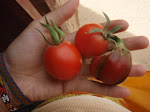
Rain
6/30/09We got our first big rains two weeks ago, signifying a sudden shift in the daily rhythm that had been more or less constant since last fall. Everything changes with the rain. Once a big enough storm has passed- meaning the ground is soaked enough that a hole dug with your foot is damp at the bottom- men, women, kids, everybody, vacate the village for the fields.
The strongest ones have the job of "sari": walking out ahead with a long, heavy hoe-type tool that they strike into the ground with every step, creating holes with small mounds of dug-out sand next to them. They make row upon row of these holes, which from a distance look like expansive, linear colonies of molehills.
The strongest ones have the job of "sari": walking out ahead with a long, heavy hoe-type tool that they strike into the ground with every step, creating holes with small mounds of dug-out sand next to them. They make row upon row of these holes, which from a distance look like expansive, linear colonies of molehills.
Following behind the Mai saris (those who do the "sari" job) come the Masu taki (those who plant). These guys- usually women and kids- hold a bowl or calabash of millet seeds in the crook of their left arm, and walk along the rows, using their right hand to drop seeds into the holes, and their right foot to push sand back over the seeds. The best, quickest planters move so smoothly that you don't even notice they are planting; they simply look like they are strolling through the field, waving their hand over the dips in the earth. It looks and feels like dancing.
There is a rush to do as much planting as possible before the soil dries out, so families spend all day every day out in the fields, working hard to get all of their millet, sorghum, beans, sesame, and peanuts in the ground. Millet is the priority; once an entire field is planted in millet, people will go back and plant the other crops in the spaces between.
We got in four full days of planting after our last good rain, enough to plant all of Narba's family's fields with millet and one of them with beans and sorghum as well. When it rains again, we'll plant the rest. It's hard work, but I really like it. I like how it brings women and men together, and how it gives everyone a common purpose in a common space. There's an etiquette to it, too- you plant in pairs if you can, so you always have a companion planting the row next to yours. Even though I was slower at first, Mariama and Rasida always, always waited for me. They'd either slow down, or double back and plant the rest of my row for me, meeting me in the middle. We talked and sang songs, and time was irrelevant.










6 comments:
Cool! Jessica-your writing is very vivid and I could picture everything.
This writing is so evocative - I love thinking of the planting as a dance.
What a clear description of both the observed and the observer's experience of it. The video is wonderful, especially getting to hear the snippet of laughter and Mariama's (beautiful name) musical speech. Hausa?
I like this video for the same reasons, Marcia! It is Hausa that you hear.
The video must be even more meaningful for you after seeing this field and hearing Mariama's voice yourself.
It is. The field in the video is so desolate, just sand. But now we have seen it when the millet has sprouted and everything is green. The millet is probably 7 feet high by now, if it has had enough rain, always a question. And Mariama is just a delight, full of smiles, and one of the 3 young women who have asked for literacy lessons in Hausa. It's great to have had that personal connection, for sure!
Post a Comment